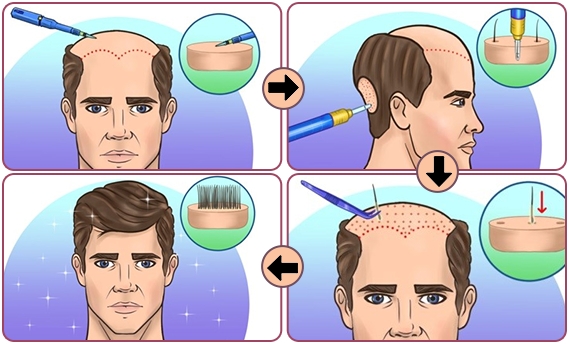What is an FUE hair transplant?
FUE is a hair restoration procedure that involves extracting and transplanting healthy human hair follicles from one part of the scalp to another. The donor area is chosen based on the quality and quantity of existing hair; the back of the head is a common choice.
Traditional hair restoration techniques, such as FUT, in which a strip of skin is taken from the rear of the head to harvest grafts, have been superseded mainly by FUE. This sophisticated operation has been developed over time.
FUE is the most common hair restoration method because its cutting-edge technology yields the most undetectable, natural-looking result with the shortest possible recovery period.
How FUE works?
It involves the removal of naturally existing groups of one to four hairs from the donor area of the scalp and the subsequent transplantation of these hairs to the location of the scalp that is generally balding.
The first step in the process will involve our doctors extracting several grafts, usually done in groups of one to four hairs. These clusters of hair are typically removed from the back of the neck or the sides of the head with the assistance of a specialized extraction device with a diameter of less than 1 millimeter. After that, the follicles are moved to the scalp area that will receive them, and a powerful stereo microscope is used to implant them there.
To guarantee that the newly transplanted hair blends in correctly and resembles a natural hair pattern, We are careful to put the hairs in at the perfect angle to make the new coat look just like the old one. This allows us to simulate the natural growth of hair.

Procedure for FUE hair transplant:
Your surgeon will trim the hair in the region around the area where the hair follicles will be destroyed as well as in the part where the transplant will take place.
They will extract the hair follicles from your skin using an instrument called a ‘micropunch’
After the follicles have been retrieved, your surgeon will make several tiny incisions using a needle or another small, sharp instrument. These incisions will serve as the recipient sites for the follicles.
They will then place the follicles into the incisions that have been made. In preparation for your recovery, your surgeon cleans and bandages the area.
Does FUE hair transplantation hurt?
FUE is a minimally invasive hair surgery method that destroys individual hair follicles one by one. The procedure is performed under local anesthesia, so patients experience little to no pain during or after the operation. During the entire time that the hair transplant process is being carried out, you will have a normal state of awareness.
During the recovery process, you may have some mild discomfort; however, this should only persist for around seven days. The likelihood of developing difficulties as a result of FUE is likewise minimal.
It is essential to remember that FUE is minimally invasive compared to older techniques such as FUT. In comparison to older methods, FUE is considered to be almost pain-free. The hair transplantation technique has advanced so much over the past ten years, and it is essential to remember that FUE is nearly pain-free.
Do’s and don’ts after hair transplantation:
Do’s:
- Use saline sprays every 2-3 hours for about 4-7 days.
- Use gentle shampoo to wash your scalp.
- Do hydrate your body well.
- Use all the medications as prescribed by the doctor.
- Take rest for about 1-2 Days.
Dont’s:
- Do not sleep flat on your tummy or side. Stay up straight.
- Do not scratch your scalp.
- Do not wear caps or Hats.
- Refrain from exercising for a few days.
- Do not have alcohol or smoke for about 2-4 weeks.
- Do not use the shower to bath instead, use a cup or jug to rinse the scalp.
Are you thinking of getting a vampire facelift? Have any queries about the treatment?
The best FUE hair transplantation specialist in Tirupati, Dr Prakash Sajja is here to solve all your queries.
Do call 9440830455 or Fill out our Appointment form to get in touch!
♥ Follow our Social Media pages for recent updates. Facebook | Instagram



